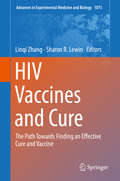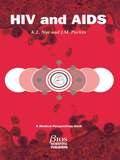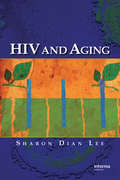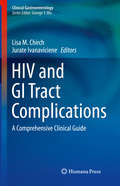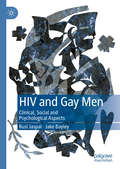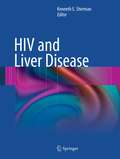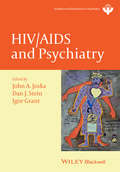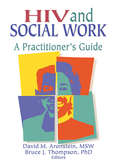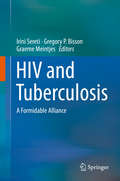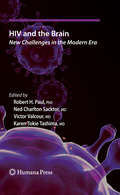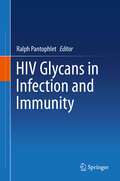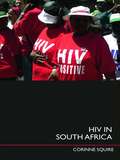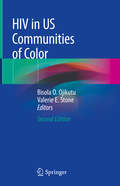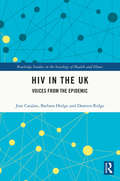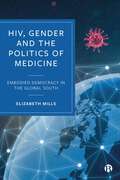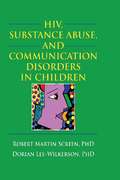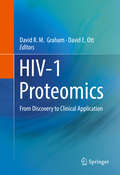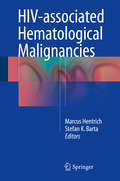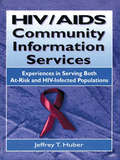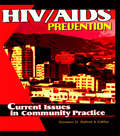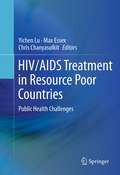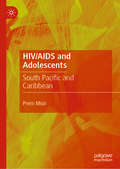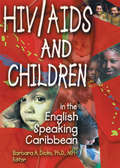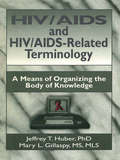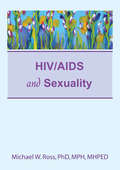- Table View
- List View
HIV Vaccines and Cure: The Path Towards Finding an Effective Cure and Vaccine (Advances in Experimental Medicine and Biology #1075)
by Linqi Zhang Sharon R. LewinThis book provides a comprehensive review of the major barriers to HIV cure and vaccine. It covers the fundamental virology and immunology leading to HIV transmission, protection from infection and long term HIV persistence on antiretroviral therapy. In addition, strategies being tested to eliminate persistent HIV and the rational design of vaccines to induce protective immunity are covered. This book also discusses the challenges related to the design of clinical trials for testing the safety and efficacy of these innovative approaches. This book will provide a systematic overview and also discuss controversial issues for researchers in virology and immunology, as well as practicing physicians, and scientists in the pharmaceutical industry.
HIV and AIDS
by K.E. Nye J.M. ParkinA comprehensive account of HIV and AIDS, the management of the disease and potential vaccines. This book is essential reading for medical students and clinicians, and of major interest to students and researchers in the life sciences.
HIV and Aging
by Sharon Dian LeeMore than two decades into the global HIV epidemic, many HIV positive patients who have access to antiretroviral medications are graying. These patients and their clinicians now face another set of complex health issues related to aging. HIV and Aging examines the known effects of HIV and HIV medications on older patients and on their immune system
HIV and GI Tract Complications: A Comprehensive Clinical Guide (Clinical Gastroenterology)
by Lisa M. Chirch Jurate IvanavicieneThis text provides a concise yet comprehensive review of GI tract complications of HIV infection. Beginning with an overview on the pathophysiology of HIV and its direct effect on the GI tract, the book outlines opportunistic infections, noninfectious etiologies, diagnostic testing, and therapy in relation to specific organs in the GI tract. Organs covered include the esophagus, stomach, gallbladder and biliary tract, liver, pancreas, and small and large intestines.Written by experts in the field, HIV and GI Tract Complications: A Comprehensive Clinical Guide is a valuable resource for clinicians and researchers interested in HIV/AIDS and associated GI tract complications, that will help guide patient management and stimulate investigative efforts.
HIV and Gay Men: Clinical, Social and Psychological Aspects
by Rusi Jaspal Jake BayleyThis book focuses on the clinical, social and psychological aspects of HIV among gay men and examines the complex factors that can contribute to HIV risk in this key population. With the target to end all HIV transmissions in the UK by 2030 in mind, Jaspal and Bayley combine elements of HIV medicine and social psychology to identify the remaining barriers to effective HIV prevention among gay men. The authors take the reader on a journey through the history of HIV, its science and epidemiology and its future, demonstrating the vital role of history, society and psychology in understanding the trajectory of the virus. Underpinned by theories from social psychology and clinical snapshots from practice, this book considers how psychological constructs, such as identity, risk and sexuality, can impinge on physical health outcomes. This refreshing and thought-provoking text is an invaluable resource for scholars, clinicians and students working in the field of HIV.
HIV and Liver Disease
by Kenneth E. ShermanLiver disease has been identified as a leading cause of death in HIV-infected patients since the introduction of highly active antiretroviral therapy (HAART) in 1996. The HIV treatment community has been caught largely unaware of this emerging dilemma. Many HIV care providers are ill-equipped to understand and interpret liver injury patterns, or to provide comprehensive care and management for viral coinfections which they are not familiar with. HIV and Liver Disease provides a comprehensive update of the field covering the epidemiology, pathogenesis, management and treatment of liver disease in patients with HIV infection. The volume will help HIV care providers understand and interpret liver injury patterns, and/or provide comprehensive care and management for viral coinfections. Gastroenterologists and hepatologists will gain an understanding of complex drug regimens that are used to treat HIV and which may impact HCV and HBV treatment. Written by expert clinicians and researchers across multiple disciplines, HIV and Liver Disease will be of great value to gastroenterologists, hepatologists, infectious disease practitioners, as well as other health care providers who provide care or participate in research in the field of HIV.
HIV and Psychiatry
by Igor Grant Dan J. Stein John A. JoskaEditorsJohn A. JoskaDepartment of Psychiatry and Mental Health, University of Cape TownDan J. SteinDepartment of Psychiatry and Mental Health, University of Cape TownIgor GrantDepartment of Psychiatry, University of California, San DiegoMental health and HIV/AIDS are closely interlinked. Mental disorders, including substance-use disorders, are associated with increased risk of HIV infection and affect adherence to and efficacy of antiretroviral treatments. Conversely, HIV infection can increase risk for neuropsychiatric complications including stress, mood, and neurocognitive disorders. This book provides clinicians with a comprehensive evidenced-based and practical approach to the management of patients with HIV infection and co-morbid mental disorders. It provides up-to-date and clear overviews of current clinical issues, as well as the relevant basic science. Information and data from studies of different HIV groups (eg men who have sex with men) make the text relevant to a broad spectrum of clinicians, including those working with low socioeconomic status groups in high income countries and those working in the developing world.The book uses the popular format of the World Psychiatric Association's Evidence and Experience series. Review chapters summarize the evidence on the epidemiology, pathogenesis and clinical aspects of mental disorders in HIV,and interventions (both psychotherapy and psychopharmacology including drug-drug interactions). These are complemented by commentaries addressing particular facets of each topic and providing insight gained from clinical experience. Psychiatrists, psychologists and all mental health staff working with HIV-infected patients will find this book of great benefit.
HIV and Social Work: A Practitioner's Guide
by R Dennis Shelby David M Aronstein Bruce J ThompsonAs HIV/AIDS continue to plague societies around the world, more and more social workers encounter HIV-infected individuals and their families and friends who are searching for help and support. In HIV and Social Work: A Practitioner's Guide, experienced social workers share their practice wisdom, knowledge, and skills on a broad range of issues. Their words of wisdom will give you the willingness to follow problems through and the flexibility and creativity that are required when dealing with issues concerning HIV/AIDS. At the same time, you will achieve a sense of empowerment and optimism as you realize that there are things you can do--very specific kinds of help you can offer--that can make an enormous difference in the lives of people with HIV/AIDS and those who love and care for them. HIV and Social Work is a practical, user-friendly resource for social workers who practice in a variety of settings and fields. You'll find it a rich and useful book if you're moving into HIV/AIDS work and want guidance, or if you're experienced and want to sharpen your skills, or if you just want to be prepared for when you find people with HIV or their family members in your office in need of help. Specifically, you'll gain valuable insight about:basic psychosocial interventions for people with HIV/AIDSin-depth practical suggestions for specific problem areas and specific groups of people with HIV/AIDS better listening skillshow to know your own limitations and live your own life more fully in the face of sadnessthe importance and challenge of returning to fundamental social work skillsYou'll refer to HIV and Social Work time and time again as you confront new HIV-related situations in your practice for which you need easy-to-understand descriptions of what to do and how to do it. Acknowledging your busy schedule, the book is organized so that you may use it on a “knowledge as needed” basis or read it straight through. Written specifically by and for social workers, HIV and Social Work is highly recommended as required reading in social work programs at the Bachelor's and/or Master's levels.
HIV and Tuberculosis: A Formidable Alliance
by Irini Sereti Gregory P. Bisson Graeme MeintjesGlobally, HIV-associated tuberculosis is one of the most important causes of infection-related death, accounting for one in every three HIV deaths and over 300,000 in 2017 alone. The HIV epidemic has undermined tuberculosis-control efforts in many countries around the world, as the virus has important modifying effects on the pathogenesis, diagnosis, and treatment of TB. The management of HIV-associated TB is also complicated by rapid clinical progression, immune reconstitution inflammatory syndrome, drug-drug interactions, and shared toxicities.The past two decades have yielded thousands of research publications and review articles on HIV-associated TB. HIV and Tuberculosis: A Formidable Alliance consolidates this massive amount of data into a single resource. With contributions from myriad disciplines, including epidemiology, immunology, public health, and clinical medicine, this book provides well-rounded and thorough coverage that will appeal to researchers and clinicians alike.
HIV and the Brain
by Karen Tokie Tashima Ned Charlton Sacktor Victor Valcour Robert H. PaulWithin the last decade there have been a number of new and important areas of emphasis in HIV care and research, particularly in the context of brain involvement. Without question, clinical and research innovations in the modern era of the HIV pandemic warrant an update on HIV and the brain. Written by a panel of leading experts, HIV and the Brain: New Challenges in the Modern Era offers a clear picture of brain impairment associated with the virus with particular focus on three emerging areas including different genetic strains of the virus throughout the world, interactions between advanced age and HIV, and the impact of HIV on the brain in the context of chronic, long-term treatment with highly active antiretroviral therapy (HAART). HIV and the Brain: New Challenges in the Modern Era provides a comprehensive review of both basic science and clinical implications in these important areas of the disease. The text is of particular relevance to both research scientists and clinicians involved in HIV in the modern era.
HIV glycans in infection and immunity
by Ralph PantophletGlycosylation is a common and extremely important modification in biological molecules, particularly of proteins. HIV Glycans in Infection and Immunity provides an overview of the roles of glycans in the transmission/infection, antigenicity, and immunogenicity of HIV and the HIV envelope glycoprotein. It explores recent advances in the understanding of the impact of HIV glycans in infection and their promise for immunological and therapeutic intervention. Novel collaborations between glycobiologists and immunologists in recent years have led to key advances in the understanding of HIV glycans. These cross-disciplinary endeavors, their achievements and their impact on the field are all addressed, herein.
HIV in South Africa: Talking about the big thing
by Corinne SquireWinner of the Sociology of Health and Illness Book Prize 2008 Of approximately 37 million HIV positive people in the world, 24.7 million live in sub-Saharan Africa and about 5..5 million in South Africa. Despite its relatively powerful economy and infrastructure, South Africa has been dramatically affected by the HIV pandemic. Using narrative analysis of a three year interview study and textual analysis of political materials, HIV in South Africa examines the impact of HIV on people's everyday lives in the country. Examining the relationship between personal accounts of living with HIV and wider medical, political and religious discourses, the book also highlights the significance of class, race and gender on individuals' experiences. These engaging stories of everyday lives provide an accessible way to connect with HIV as a health and development issue. Fascinating, challenging and constructive, this is an important contribution in an area of great social relevance. The ebook is available free of charge to those with addresses on the United Nations Development Programme's Human Development Index of Medium and Low Rankings (see http://hdr.undp.org/hdr2006/pdfs/report/HDR_2006_Tables.pdf), who can apply to the following address: www.ebookstore.tandf.co.uk
HIV in US Communities of Color
by Bisola O. Ojikutu Valerie E. StoneThis book builds upon its previous edition by comprehensively updating important epidemiologic and clinical content of the HIV continuum amongst Black and Latino individuals of the United States, including the epidemiology, prevention, diagnosis, and treatment of HIV within these diverse communities. Illuminating current diagnostic and prevention considerations, as well as its evidence base, the text highlights important concepts and integrates critical aspects of the structural and social environment, such as mass incarceration and neighborhood-level disadvantage, that compromise our ability to decrease HIV risk and improve outcomes. Discussion regarding significant predictors of health inequity, including discrimination, medical mistrust, and stigma, specifically homophobia and transphobia, are included. The book also reviews the impact of significant advances in HIV prevention, such as pre-exposure prophylaxis (PrEP), within Black and Latino communities. Written by experts in their field, this second edition of HIV in US Communities of Color is a comprehensive and dynamic resource for all health care providers who support the care and treatment of Black and Latino individuals at risk for or living with HIV.
HIV in the UK: Voices from the Epidemic
by Jose Catalan Damien Ridge Barbara HedgeThis book explores the thoroughly human dimension of the health care and prevention responses to the HIV crisis in the UK, and the impact that such initiatives had on the progression of the epidemic. This book presents a compelling account of the unfolding of the epidemic and the initiatives that made all the difference in the care and prevention of HIV in the UK from the early 1980s to the present time. Drawing on interviews with people with HIV, doctors and nurses involved in their care, leaders of AIDS charities, activists, and politicians, it identifies and describes the models of care developed in response to the onset of the HIV epidemic, and its impact on NHS and voluntary organizations. It goes on to explore the political responses, the evolution of HIV stigma, and the personal impact of the early high mortality rates. Finally, it discusses recent organizational changes in the provision of care and prevention services. In doing so, this volume identifies the lessons learnt from the care and prevention of HIV, both in relation to HIV infection and other conditions, such COVID-19, and discuss future challenges. This book will be of great value to those working in services dealing with HIV, charities, and CCGs and GP organizations, as well as social historians and medical sociologists.
HIV, Gender and the Politics of Medicine: Embodied Democracy in the Global South
by Elizabeth MillsThis book centres on women living with HIV in South Africa who have navigated affective relationships, activist networks, government institutions and global coalitions to transform health policies that govern access to HIV medicines. Drawing on 20 years of ethnographic and policy research in South Africa, Brazil and India, it highlights the value of understanding the embodied and political dimensions of health policy and reveals the networked threads that weave women’s precarity into the governance of technologies and the technologies of governance. It illuminates the entwined histories of health policy evolution, systemic inequality and everyday life and calls for a recognition of the embodied ramifications of democratic politics and global health governance. By integrating medical anthropology with science studies and political theory, this book traces the history of the struggle to access HIV medicines in the Global South and brings it into the present by articulating the lessons learned by activists and policy makers engaged in shaping these vital health policies.
HIV, Substance Abuse, and Communication Disorders in Children
by R. Dennis Shelby Robert M. ScreenMake sure every child gets a chance to be heardHIV, Substance Abuse and Communication Disorders in Children examines the language problems of young children from special populations. Essential as a textbook for graduate and upper-level undergraduate studies and as a reference resource, this unique book presents up-to-date research and compelling case studies that illustrate how prenatal exposure to drugs, alcohol, and HIV can affect a child in utero and continue to handicap its development after birth. Each chapter includes discussion threads and review questions to promote critical thinking and clinical problem-solving skills in the classroom.HIV, Substance Abuse and Communication Disorders in Children looks at the negative impact a mother&’s lifestyle practices can have on her developing child with a nod toward the significant prevalence of HIV and substance abuse in today&’s society. Some estimates place the number of infants born after prenatal exposure to illicit drugs as three-quarters of a million-every year. When alcohol is added, the figure rises to more than 1 million. This powerful book focuses specifically on the serious consequences of alcohol, marijuana, cocaine, and crack cocaine abuse, including poor language development and speech delays, limited vocabulary, the inability to make their needs known, poor articulation, the inability to follow commands, limited expressive language skills, and the inability to understand the real meaning of words and generalize them. And of the nearly 5,000 children in the United States living with AIDS, almost all will struggle with speech production and communication disorders as the disease affects their brain, spinal cord, and central nervous system. HIV, Substance Abuse and Communication Disorders in Children examines: the effect of drugs on the brain pregnancy and drug use trends common drugs of abuse Kosakoff&’s syndrome fetal alcohol syndrome (FAS) among Native Americans and African Americans neurologic sequellae speech and language intervention rehabilitation considerations treatment and family counseling and much moreHIV, Substance Abuse and Communication Disorders in Children is essential for graduate and undergraduate students working with language disorders in special populations.
HIV-1 Proteomics
by David R. M. Graham David E. OttThe development of proteomic analyses using advanced mass spectrometry techniques has revolutionized the way proteins are studied, namely, as individual molecules within a complex system. HIV-1 Proteomics: From Discovery to Clinical Application comprehensively covers protein analysis from the early classic experimental days to current state-of-the-art HIV-1 proteomics in a clear informative style that brings expert-level understanding to the novice. Discussion of important clinical applications and future directions for the field also make this an ideal read for the expert. After finishing this book, the reader will have a complete and functional understanding of protein analysis from traditional biochemistry to modern proteomics.
HIV-associated Hematological Malignancies
by Marcus Hentrich Stefan K. BartaThis book presents a general introduction to and review of HIV-associated hematological malignancies, with a special focus on practical management issues. Each of the relevant malignancies is addressed individually, with an overview of treatment approaches, assessment of evidence regarding their efficacy, and discussion of therapeutic controversies. In addition, careful consideration is paid to issues in molecular and clinical pathology, epidemiological aspects, symptomatology, diagnosis, and risk factors. Separate chapters are devoted to autologous and allogeneic stem cell transplantation and to chemotherapy and interactions with antiretroviral agents. Many of the chapters are written by experts who have been instrumental in shifting the balance for people living with HIV and blood cancers. While two decades ago this diagnosis represented a death sentence, advances in treatment have transformed these cancers into often curable conditions. Nevertheless, optimal treatment of hematological malignancies remains a challenge, particularly in patients with severe immunosuppression. This book will be an invaluable source of information for all practitioners in the fields of clinical hematology and medical oncology and HIV medicine.
HIV/AIDS Community Information Services: Experiences in Serving Both At-Risk and HIV-Infected Populations
by M Sandra Wood Jeffrey T HuberInformation forms the basis for education, and currently education is the only weapon available to stem the spread of HIV/AIDS and to foster empathy toward individuals already affected by the disease. HIV/AIDS and Community Information Services provides readers with insight into the information construct within the AIDS arena and how that construct affects the provision of information services to the HIV/AIDS affected population. It will serve as an irreplaceable reference as the number of individuals with AIDS increases, creating a greater demand for information and making that information increasingly difficult to provide.While directories exist to assist with practical approaches to accessing HIV/AIDS-related information, none had served as a comprehensive resource concerning the nature of that information or the provision of information services. HIV/AIDS Community Information Services fills that void. It fosters the enlightenment of the general public concerning the true nature of HIV/AIDS, guides readers in providing information services--both educational and recreational--to individuals affected by HIV/AIDS, and encourages the dissemination of instructional materials to those individuals at risk for infection. In doing so, contributors provide readers with information about: the relationship between AIDS and the body of information concerning the disease the complex nature of HIV/AIDS-related information available HIV/AIDS information services information as a means for empowerment suggestions for future programs, potential collaboration efforts, and innovative servicesAn essential guide for information professionals, librarians, health educators, counselors, members of community-based AIDS service organizations, and individuals affected by HIV/AIDS, HIV/AIDS Community Information Services foster the creation, accession, collection, organization, dissemination, and sharing of information concerning the HIV/AIDS epidemic and promotes the provision of services to individuals already affected by HIV/AIDS.
HIV/AIDS Prevention: Current Issues in Community Practice
by Doreen D. SalinaDevelop a positive working relationship between researchers and community groups focusing on HIV/AIDS prevention, and discover how to evaluate HIV/AIDS programs! An indispensable manual for everyone involved with HIV/AIDS research, prevention techniques, and the needs of individuals with HIV/AIDS, HIV/AIDS Prevention: Current Issues in Community Practice covers everything from the likelihood of condom usage by college women to the psychological effects on minority men infected with the HIV/AIDS virus. Essential reading for psychologists, research scientists who work with communities or who are involved in AIDS prevention programs, and for care takers of people with HIV/AIDS, Contemporary Topics in HIV/AIDS Prevention covers the necessary collaborative steps needed to create a positive researcher/community based organization (COB) partnership that will benefit researchers and those affected by the disease. In HIV/AIDS Prevention, you will examine many different models designed to effectively foster a positive researcher/CBO relationship while learning how to overcome problems you may encounter when researching a social issue or working with a researcher. This book also explains how and why many HIV prevention programs have been poorly evaluated due to a lack of funds and social politics. In addition, you will discover how you can obtain and/or perform a true evaluation of an HIV prevention program. In HIV/AIDS Prevention, you will explore many important issues and factors that help create successful programs, including: factors necessary for valid HIV/AIDS prevention program evaluations assessments of coping strategies, psychological variables, and the physical well-being of African- American and Latino men living with HIV/AIDS steps for the collaborative process between researchers and community groups making a good match between community-based organizations and researchersHIV/AIDS Prevention gives you pertinent information and guidelines for selecting a community-based organization to work with and the steps to creating a successful relationship. This book will give you the strategies and information you need in order to give pastoral support and prevention education to at-risk individuals. You will discover what is necessary for a true HIV/AIDS prevention program evaluation.
HIV/AIDS Treatment in Resource Poor Countries
by Chris Chanyasulkit Yichen Lu Max EssexThe book focuses on HIV/AIDS prevention and treatment strategies in resource-poor settings. Contributors include HIV/AIDS researchers and public health administrators from the US, Africa, China, and Thailand. Several chapters, written by local health officials, take a close look at AIDS prevention and treatment in China at the community level. Other chapters cover issues of treatment scale-up, drug resistance, and mother-to-child transmission in Southern Africa and Thailand, and offer lessons learned for researchers in other developing countries. Overall the aim of this book is to bring some of the latest issues to the fore, and to foster exchange and collaboration between AIDS researchers in developing countries. This book grew out of an annual conference held in China and organized by the Harvard School of Public Health, and could possibly become the first volume of a series.
HIV/AIDS and Adolescents: South Pacific and Caribbean
by Prem MisirThis book addresses the relationship between high school students’ HIV and AIDS knowledge and their stigma-related attitudes/perceptions of people living with HIV (PLHIV) in the Caribbean and South Pacific, with a view to designing effective stigma-reduction combined intervention programs. Presenting an international cross-sectional study using a purposive sample of high school students from Fiji (South Pacific), Vanuatu (South Pacific), Guyana, and Antigua & Barbuda (Caribbean) to assess HIV and AIDS knowledge and stigma-related attitudes by gender, age, religion, race/ethnicity, and socioeconomic status, the book shows how stigmatizing attitudes and beliefs negatively impact interventions to prevent and treat HIV and AIDS.
HIV/AIDS and Children in the English Speaking Caribbean
by Barbara A DicksExamine the biopsychosocial, environmental, spiritual, and policy issues that affect HIV/AIDS prevention/service delivery issues for Caribbean youth!This groundbreaking book provides an overview and informed discussion of HIV/AIDS as it affects children and adolescents in Antigua, Barbados, Grenada, Jamaica, and The Republic of Trinidad and Tobago. With contributions from noted HIV/AIDS experts in the region, it examines the biopsychosocial, environmental, spiritual, and policy issues that impact HIV/AIDS prevention/service delivery issues for Caribbean youth. HIV/AIDS and Children in the English Speaking Caribbean breaks the silence on this subject that has existed throughout the Caribbean--second only to Sub-Saharan Africa in terms of the number of people infected with the disease--by focusing attention on the issues, needs, perspectives, policies, and research that impact those affected by the epidemic in that region. This unique book gives special attention to the distinctive differences among Caribbean countries with varying customs based on colonial influences including language, culture, traditions, and religion. User-friendly tables and figures make the statistical information easy to understand.HIV/AIDS and Children in the English Speaking Caribbean discusses a diversity of topics, including: psycho-cultural issues and adolescents the impact of dance hall music on HIV and adolescents school programs evaluation of residential placements for children with AIDS sexual risk-taking behaviors of Jamaican street boys the inaugural lecture on AIDS at the University of the West Indies . . . and much more. Everyone whose professional life brings them into contact with this population, including social workers, psychologists, counselors, clinicians, nurses and other health care professionals, as well as educators and their students will find HIV/AIDS and Children in the English Speaking Caribbean a very useful resource for understanding the devastating impact of the HIV/AIDS virus on children and adolescents in that part of the world.
HIV/AIDS and HIV/AIDS-Related Terminology: A Means of Organizing the Body of Knowledge
by M Sandra Wood Jeffrey T Huber Mary L GillaspyHIV/AIDS and HIV/AIDS-Related Terminology: A Means of Organizing the Body of Knowledge offers an adaptable and extensive framework for organizing the ever-expanding number of resources on the HIV/AIDS epidemic. It lays down the groundwork upon which future blocks of information can be placed. As new information becomes available, it can be integrated into this system without rearranging the information already stored. This saves the time and money associated with revising a less flexible existing system. The book’s instructions for use and taxonomic classification system make it easy to use. HIV/AIDS and HIV/AIDS-Related Terminology is designed for use in any setting where HIV/AIDS healthcare or information services are provided. It acts as a guide to available resources and illustrates how to acquire the most up-to-date information. At the same time, it moves beyond the more general focus on the clinical, legal, and medical ramifications of HIV/AIDS to the development of an interdisciplinary cataloging system that includes all issues and topics associated with the disease. This invaluable reference tool leaves no rock unturned. It addresses every conceivable facet of the epidemic, from the psychological to the religious and from the economic to the social. Any organizations or institutions concerned with the collection, creation, management, and dissemination of HIV/AIDS-related materials will find this book an essential for their libraries. Practical and comprehensive, HIV/AIDS and HIV/AIDS-Related Terminology addresses a full range of topics, including: prevention and education epidemiology and transmission treatment funding opportunities health policy HIV/AIDS and the fine artsHIV/AIDS and HIV/AIDS-Related Terminology is the first book to provide a method for grappling with the vast scope of information on the HIV/AIDS epidemic. Its organic structure is designed to accommodate new knowledge as it becomes available, while it maximizes access to existing information in a variety of formats.
HIV/AIDS and Sexuality
by Michael W RossIn this important book, editor Michael Ross brings together the latest knowledge and research concerning the relationship between HIV and AIDS and sexual functioning. HIV/AIDS and Sexuality explores the experiences of being HIV-infected and the impact of infection on an individual's sexuality. It describes differences that may be associated with individuals who are infected or concerned about infection, and it provides new in-depth analyses of the effect of HIV on sexuality and sexual risks. The book provides clinical perspectives on sexual problems associated with HIV infection as well as some treatment approaches. Contributing authors represent the United States, Australia, and Europe and discuss heterosexual men and women, gay men, lesbians, and injecting drug users. This diversity provides a more complete picture of the experiences of people with HIV in terms of explicit and implicit sexuality. Chapters include cross-sectional and cohort study designs as well as qualitative, quantitative, and clinical approaches. Some of the topics explored are:the centrality of sexuality to equality of life and identity and the impact of HIV on sexuality in gay-identified menthe psychological impact of making changes in sexual behavior on gay men with HIV infectionrisk behaviors in seropositive and seronegative womena study of a cohort of HIV-infected women associated with the militarysexual addiction in gay men and its association with HIV risksovert and subtle communications processes that occur between health care providers and clients about sexuality and HIVstages of change in safer sexual practices in a cohort of gay menpersonality variables associated with risk and infection in both homosexual and heterosexual menHIV/AIDS and Sexuality opens up the area of sexuality in people living with HIV and focuses much-needed attention on the issues involved in sexual expression, HIV transmission risk, and living with HIV infection. This book is an illuminating exploration into the subject that helps professionals better understand their clients and thus provide more compassionate and effective care.
